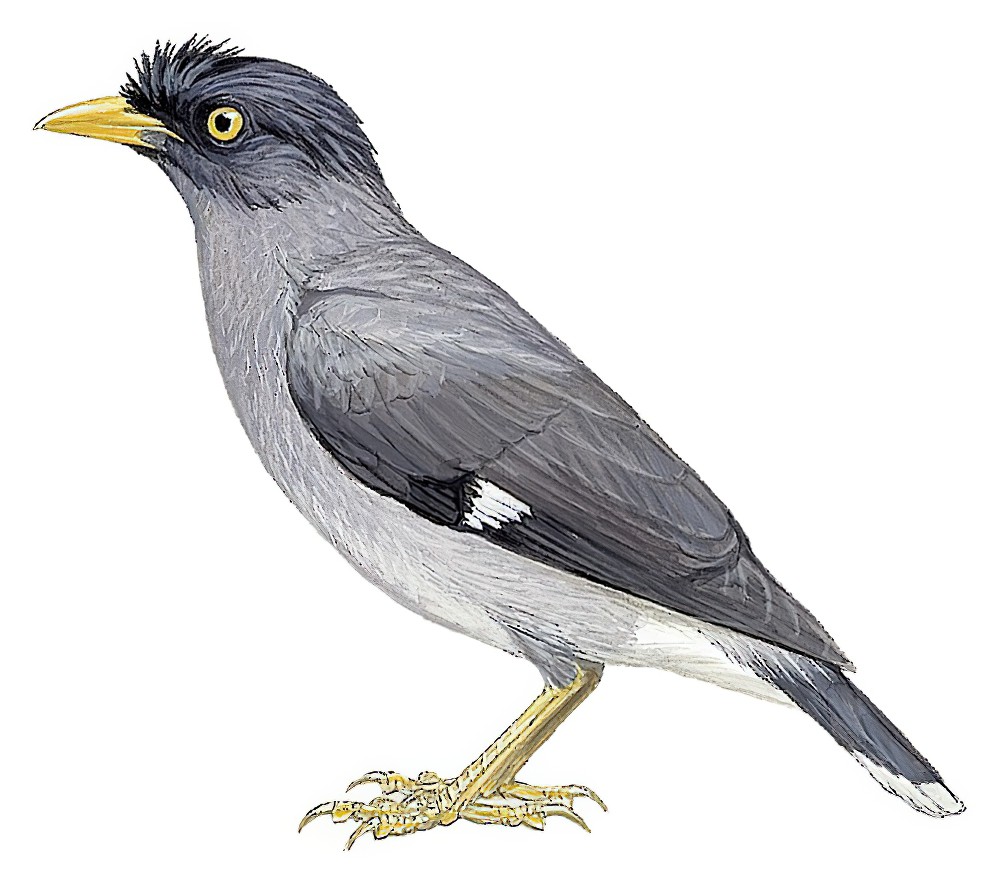Pale-bellied Myna / Acridotheres cinereus

Pale-bellied Myna
SCI Name:
Protonym: Acridotheres cinereus Consp.Gen.Av. 1 p.420 ydP
Taxonomy: Passeriformes / Sturnidae / Acridotheres
Taxonomy Code: pabmyn1
Type Locality: Celebes.
Author: Bonaparte
Publish Year: 1850
IUCN Status: Vulnerable
DEFINITIONS
ACRIDOTHERES
(Sturnidae; Ϯ Common Myna A. tristis) Gr. ακρις akris, ακριδος akridos locust; -θηρας -thēras -hunter < θηραω thēraō to hunt < θηρ thēr, θηρος thēros beast, animal. "MARTIN, Acridotheres. Paradisea, Gracula, Turdus, Linn. Gm. Lath. Bec droit, tendu, convexe en dessus, comprimé; mandibule supérieure, entière ou échancrée, un peu déprimée et inclinée vers le bout. — Tête en partie, ou seulement les orbites glabres. 2 sections. Esp. Martin. — Merle-chauve, Buff. — Martin brame, Sonnerat. ... Acridothera [ακρις, locustella, θηραω, venor]." (Vieillot 1816); "Acridotheres Vieillot, 1816, Analyse, p. 42. Type, by subsequent designation (Gray, 1840, List Gen. Birds, p. 40), Paradisea tristis Linnaeus." (Amadon in Peters 1962, XV, 112).
Var. Acridothera, Acridotherss, Cridotheres.
Synon. Aethiopsar, Graculaea.
cinereum / cinereus
L. cinereus ash-grey, ash-coloured < cinis, cineris ashes.
● ex “Cinereous or Ash-coloured Vulture” of Willughby 1676, and Latham 1781, “Vultur cinereus” of Ray 1713, “Vultur fusco-nigricans” of Brisson 1760, and “Vautour” or “Grand Vautour” of d’Aubenton 1765-1781, pl. 425, and de Buffon 1770-1783 (syn. Aegypius monachus).
● ex “Maracana” of Willughby 1676, “Maracana Brasiliensibus” of Ray 1713, “Psittacus brasiliensis cinereus” of Brisson 1760, and “Cinereous Parrot” of Latham 1781 (?syn. Anodorhynchus glaucus).
● ex “Gobe-mouche roux de Cayenne” of Brisson 1760 (syn. Attila rufus).
● ex “Falco freti Hudsonis” of Brisson 1760, “Faucon de la Baie d’Hudson” of de Buffon 1770-1783, and “Ash-coloured Buzzard” of Latham 1781 (syn. Buteo buteo).
● ex “Cinereous Wattle-bird” of Latham 1781 (Callaeas).
● ex “Ash-bellied Humming-bird” of Latham 1782 (syn. Campylopterus largipennis).
● ex “Gavilan del campo ceniciento” of de Azara 1802-1805, nos.32, 33 (Circus).
● ex “Grive de Cayenne” of d’Aubenton 1765-1781, pl. 515 (?Cotinga sp.).
● ex “Tinamou cendré” of de Buffon 1770-1783, and “Cinereous Tinamou” of Latham 1785 (Crypturellus).
● ex “Cotinga Cendré” of Levaillant 1801 (syn. Lipaugus vociferans).
● ex “Wax-billed Barbet” of Latham, 1782 (syn. Monasa niger).
● (Boddaert 1783) ex “Manakin cendré de Cayenne” (= ♂) of d’Aubenton 1765-1781, pl. 687, fig. 1, and “Oiseau cendré de la Guyane” of de Buffon 1770-1785 (syn. Pachyramphus rufus).
● (J. Gmelin 1789) ex “Cinereous Manakin” of Latham 1783 (syn. Pachyramphus rufus).
● ex “Mésange Grise au Joue Blanche” of Levaillant 1804, pl. 139, fig. 2 (Parus).
● ex “Oiseaux grises” or “Oies de plein” of Pernety 1769, “Race horse Duck” of Pernety 1771, and “Loggerhead Goose” of Latham 1785 (syn. Tachyeres brachypterus).
● ex “Grey and Yellow Flycatcher” of Edwards 1751 (Todirostrum).
● "57. MEROPS. ... cinereus. 3. M. rubro flavoque variegatus, subtus flavo-rubescens, rectricibus duabus longissimis rubris. Avicula de gvauheilui [= Quauhcilui]. Seb. mus. I. p. 50. t. 30. f. 10. Habitat in America." (Linnaeus 1758) (unident.; nom. dub.)
● (Forster 1781) ex “Merula Indica cinerea” of Brisson 1760 (unident.).
● (J. Gmelin 1789) ex “Merula Indica cinerea” of Brisson 1760, “Merle cendré des Indes” of de Buffon 1770-1783, and “Ash-coloured Thrush” of Latham 1783 (unident.).
UPPERCASE: current genus
Uppercase first letter: generic synonym
● and ● See: generic homonyms
lowercase: species and subspecies
●: early names, variants, mispellings
‡: extinct
†: type species
Gr.: ancient Greek
L.: Latin
<: derived from
syn: synonym of
/: separates historical and modern geographic names
ex: based on
TL: type locality
OD: original diagnosis (genus) or original description (species)












